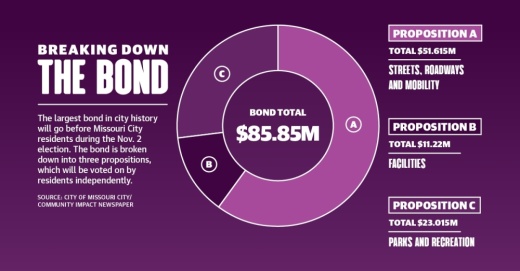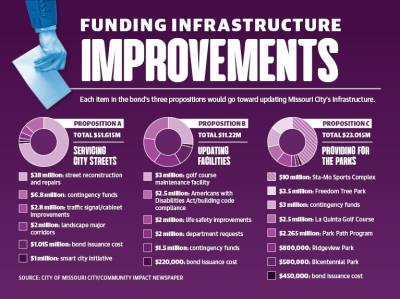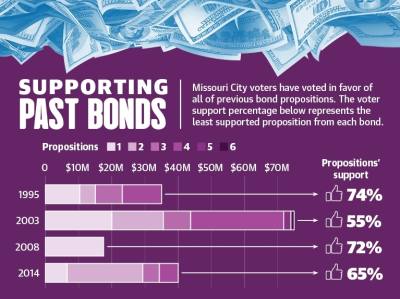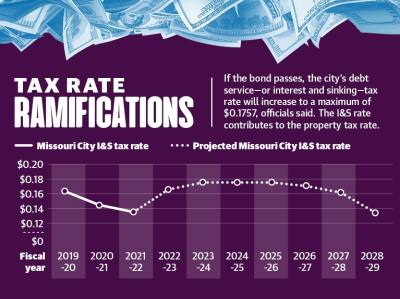Broken into three propositions, the bond revenue would go toward infrastructure improvements for streets and mobility, facilities, and parks and recreation, Missouri City officials said.
The bond package was recommended to City Council in July by the Missouri City Bond Exploratory Committee, a group of Missouri City residents that reviewed the need for a bond and its included projects.
More than half of the bond—$51.615 million—is dedicated to streets, roadways and mobility projects, including reconstructing more than 80 city streets.
“You’ll see that streets are the [most expensive] because there are so many lane miles of streets in a community; it is an expensive proposition to maintain them,” interim City Manager Bill Atkinson said.
Upgrades at city buildings and parks make up the other two bond propositions, which total $11.22 million and $23.015 million, respectively.
If each proposition passes, city staff estimates Missouri City residents in Fort Bend County will see an average increase of $78 in their annual property tax bill with a $51 average increase for Harris County residents.
Atkinson said bonds support multigenerational development, with the cost of the projects spread out over time so those who benefit from the updates share the cost of them.
“Missouri City has aging communities, especially the north part of Missouri City,” former City Council Member Don Smith said. “The infrastructure is eroding, and it would be a significant undertaking to ever catch up with the erosion of streets and sidewalks, so that part of the bond referendum is extremely important.”
Aging infrastructure
Some areas of Missouri City are more than 50 years old, meaning the roads in these neighborhoods have surpassed the typical 30-year lifespan of concrete, Atkinson said.
“This city is 50-plus years old. The streets and infrastructure that were built back then were supposed to last 30 years—they’ve overlasted their age,” Public Works Director Shashi Kumar said at a July bond information session. “It’s time to rebuild that.”
Proposition A, which is dedicated to street and mobility improvements, totals $51.615 million and allocates $38 million to completely reconstruct more than 80 city streets, including Court Road, Scanlin Road and Lake Olympia Parkway.
Kumar said streets were prioritized for reconstruction according to a citywide assessment of pavement. The number of streets in Missouri City needing replacement exceeds the bond—with Kumar estimating the city has $108 million of streets needing complete reconstruction.
“It’s a data-driven approach,” he said. “We will fix those streets that are in the worst conditions.”
The remaining $13.615 million would go toward upgrading traffic signals, landscaping along major corridors and implementing a smart city initiative.
The $11.22 million Proposition B also aims to update aging building infrastructure, Atkinson said. It would fund projects that bring the city’s older buildings up to code and compliance with the Americans with Disabilities Act as well as other updates.
“Prop B is for accessibility [and] to make sure we have the life safety issues covered for not only our patrons, but also our employees and other visitors,” Atkinson said.
Park improvements
Proposition C, which totals $23.015 million, would infuse money into four of Missouri City’s 20 parks: Bicentennial Park, Freedom Tree Park, Ridgeview Park and the Sta-Mo Sports Complex. It would also add or improve trails at five parks.
Parks and Recreation Director Jason Mangum said his department is seeing park infrastructure age.
“Just like the streets, many of these parks are decades old—up to 40 [and] 50 years old—and need much-needed improvements,” Mangum said during the July session.
The largest project that could be funded through Proposition C is the transformation of the Sta-Mo Sports Complex at the intersection of Court Road and Moore Road.
The $15 million project—$10 million of which would be funded through the bond with the remaining $5 million from Fort Bend County—would convert the existing baseball and softball fields so they can be used for other outdoor sports. The project would also improve the parks’ drainage system and structures, and it would add pickleball courts, basketball courts and playgrounds.
“This would turn this park from really an eyesore and a troubled portion of our community into something that we could really be proud of,” Mangum said.
The proposition also includes $3.5 million of enhancements to Freedom Tree Park. According to city renderings, funding from the bond would add pavilions, playgrounds and a labyrinth to five acres of land adjacent to the Freedom Tree. Additionally, an educational trail explaining the tree’s history would connect Community Park to Freedom Tree Park.
Smith, who is the chair of the Missouri City Juneteenth Celebration Foundation, said slaves on the Palmer Plantation received news of the Emancipation Proclamation under the Freedom Tree.
“The Freedom Tree is one of the crown jewels of Missouri City,” Smith said. “[This design] gives another venue for families in that area to congregate. ... It’s a very beautiful design.”
Renovations to the La Quinta Golf Course’s cart paths and drainage systems at the Quail Valley City Centre would also be funded through the parks and recreation proposition.
Council Member Vashaundra Edwards was the only vote against calling the bond election at an Aug. 16 meeting. She said she objected to spending $800,000 in Proposition C to replace pavilions, a restroom, a trail and a playground at Ridgeview Park, following an Aug. 2 meeting where City Council approved spending $66,000 on the park to install a splash pad. The remaining cost of the splash pad will be covered by external donations.
“I find that highly appalling that we are going to spend that amount of money on one particular park,” Edwards said. “[We] have other parks that need treatment, need refurbishing, need repairing.”
Financial implications
If the bond passes in full, the maximum debt service, or interest and sinking tax rate, needed to support the bond would be $0.1757. Financial Services Director Allena Portis said this represents a $0.04089 increase over the I&S tax rate adopted Sept. 20 for fiscal year 2021-22.
The I&S rate accounts for one of two parts of the city’s overall property tax rate; the other is the maintenance and operations rate. However, the M&O rate is adopted by City Council each year and could fluctuate depending on property values and the city’s budgetary needs, Portis said. Over the past five years, the M&O rate has increased 0.68%, ranging from $0.44023 to $0.46639 per $100 valuation.
If approved, debt from the bond would begin to be issued in FY 2022-23, Atkinson said. This means residents can expect to see some funded bond projects begin as soon as late 2022, spanning three to five years.
Of Missouri City’s four most recent bonds, all 15 propositions have passed. To date, the city’s most expensive bond was a $75 million package in 2003.
“Bonds are means in which cities are able to raise funds for large capital projects,” Atkinson said. “Capital is very expensive.”








